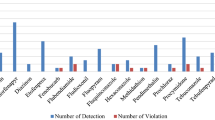Abstract
The production of apples in Poland is the largest among the countries of the European Union, and therefore, the consumption of these fruits is high in our country. The aim of this study was to determine the presence of pesticide residues in Polish apples and to assess if these residues pose a risk to the health of the consumer. Furthermore, compliance with legal regulations concerning the use of plant protection products in crop cultivation was ascertained. Pesticide residues were found in 192 samples (61.5 % of tested samples). In six samples (1.9 %), residues exceeded maximum residue limits. Violations concerned the insecticides: indoxacarb, diazinon and fenitrothion. The highest long-term consumer exposure was found in the case of consumption of apples with diazinon residue for both groups, adults and toddlers [4 % acceptable daily intake (ADI), adults; 21 % ADI, toddlers]. The highest values of short-term exposure were obtained in the case of consumption of apples with indoxacarb [5 % acute reference dose (ARfD), adults; 27 % ARfD, toddlers] and fenitrothion (4 % ARfD, adults; 23 % ARfD, toddlers). Although fungicides are the pesticides found most often in apples, the consumption of apples with insecticide residues constitutes the greatest hazard to human health.
Similar content being viewed by others
References
Chmiel, Z. (1979). Spectrometric determination of dithiocarbamate residues in plant material. Chemical Analysis, 24, 505–512.
Document SANCO (2011) Document SANCO/12495/2011. Method validation and quality control procedures for pesticide residues analysis in food and feed, pp. 40.
Eurostat (2011). Eurostat yearbook 2011. Europe in figures. ISBN 978-92-79-18414-7, pp. 699, doi:10.2785/12017.
Eurostat (2012). Eurostat yearbook 2012. Europe in figures. ISBN 978-92-79-22085-2, pp. 698, doi:10.2785/20539.
ISO/IEC (2005) ISO/IEC 17025: 2005 General requirements for the competence of testing and calibration laboratories, PKN, Warszawa, pp. 67.
Konopacka, D., Jesionkowska, K., Kruczyńska, D., Stehr, R., Schoorl, F., Buehler, A., et al. (2010). Apple and peach consumption habits across European countries. Appetite, 55(3), 478–483.
Łozowicka, B., & Kaczyński, P. (2011). Pesticide residues in apples (2005–2010). Archives of Environmental Protection, 37(3), 43–54.
Murawska, A. M. (1980). Method of bioautography applied for the determination of residues of benzimidazol fungicides. Prace Naukowe Instytut Ochrony Roślin, 22(1), 139–149.
Nowacka, A., & Gnusowski, B. (2007). Estimation of the dietary exposure to pesticide residue in polish crops in 2006. Journal of Plant Protection Research, 47(4), 469–475.
Regulation EC (2005) Regulation (EC) No 396/2005 of the European Parliament and of the Council of 23 February 2005 on maximum residue levels of pesticides in or on food and feed of plant and animal origin and amending Council Directive 91/414/EEC. Off. J. L 70, with later amendments.
Regulation EC (2009) Regulation (EC) No 1107/2009 of the European Parliament and of the Council of 21 October 2009 concerning the placing of plant protection products on the market and repealing Council Directives 79/117/EEC and 91/414/EEC. Off J. L 309, with later amendments.
Sadło, S. (1998). Partition coefficient—its determination and significance in estimation of pesticide residue losses in the course of extraction procedure. Journal of Plant Protection Research, 38(2), 179–184.
Valverde-Garcia, A., Gonzalez-Pradas, E., & Aguilera-des Real, A. (1993). Analysis of buprofezin residues in vegetables. Application to the degradation study on eggplant grown in a greenhouse. Journal of Agricultural and Food Chemistry, 41(12), 2319–2323.
WHO (2008). Dietary exposure assessment of chemical in food. Report of Joint FAO/WHO Consultation, Annapolis, Maryland, USA, 2–6 May 2005, pp. 88.
WHO (2011a) WHO templates, A template for the automatic calculation of the IESTI, http://www.who.int/entity/foodsafety/chem/IESTI_calculation_ver12c.xlt Version 12c; dd 28 September 2011.
WHO (2011b) WHO templates, Spreadsheet for the evaluation of chronic exposure, http://www.who.int/entity/foodsafety/chem/IEDI_calculation14_FAO1.xlt Version 14, dd 31 August 2011.
Author information
Authors and Affiliations
Corresponding author
Rights and permissions
About this article
Cite this article
Szpyrka, E., Kurdziel, A., Słowik-Borowiec, M. et al. Consumer exposure to pesticide residues in apples from the region of south-eastern Poland. Environ Monit Assess 185, 8873–8878 (2013). https://doi.org/10.1007/s10661-013-3219-y
Received:
Accepted:
Published:
Issue Date:
DOI: https://doi.org/10.1007/s10661-013-3219-y




